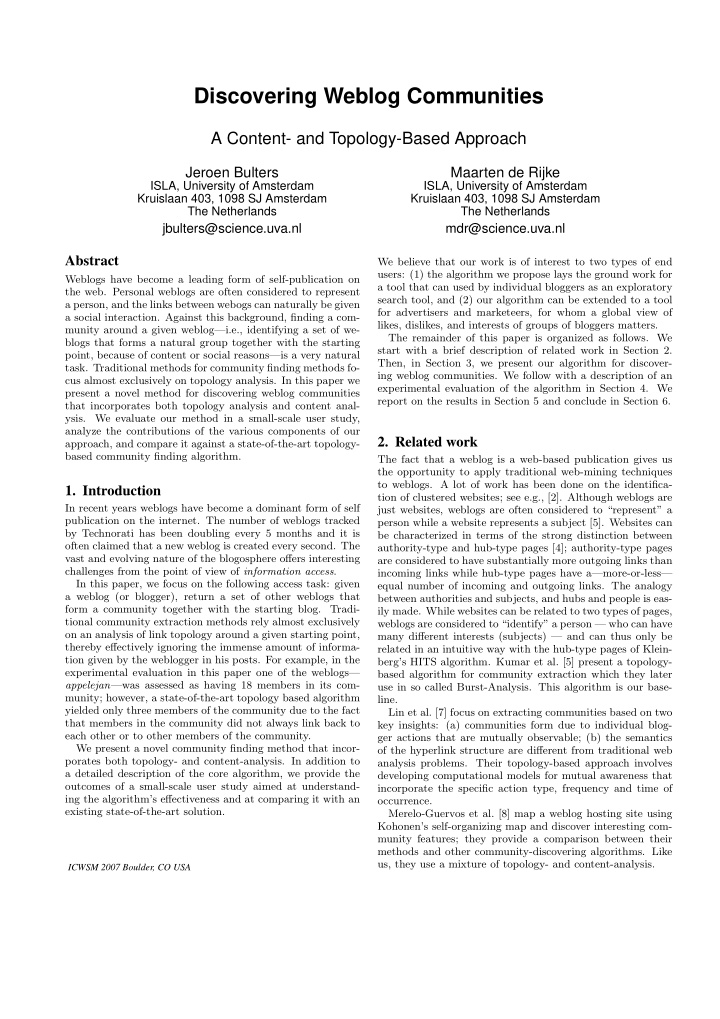



Discovering Weblog Communities A Content- and Topology-Based Approach Jeroen Bulters Maarten de Rijke ISLA, University of Amsterdam ISLA, University of Amsterdam Kruislaan 403, 1098 SJ Amsterdam Kruislaan 403, 1098 SJ Amsterdam The Netherlands The Netherlands jbulters@science.uva.nl mdr@science.uva.nl Abstract We believe that our work is of interest to two types of end users: (1) the algorithm we propose lays the ground work for Weblogs have become a leading form of self-publication on a tool that can used by individual bloggers as an exploratory the web. Personal weblogs are often considered to represent search tool, and (2) our algorithm can be extended to a tool a person, and the links between webogs can naturally be given for advertisers and marketeers, for whom a global view of a social interaction. Against this background, finding a com- likes, dislikes, and interests of groups of bloggers matters. munity around a given weblog—i.e., identifying a set of we- The remainder of this paper is organized as follows. We blogs that forms a natural group together with the starting start with a brief description of related work in Section 2. point, because of content or social reasons—is a very natural Then, in Section 3, we present our algorithm for discover- task. Traditional methods for community finding methods fo- ing weblog communities. We follow with a description of an cus almost exclusively on topology analysis. In this paper we experimental evaluation of the algorithm in Section 4. We present a novel method for discovering weblog communities report on the results in Section 5 and conclude in Section 6. that incorporates both topology analysis and content anal- ysis. We evaluate our method in a small-scale user study, analyze the contributions of the various components of our 2. Related work approach, and compare it against a state-of-the-art topology- based community finding algorithm. The fact that a weblog is a web-based publication gives us the opportunity to apply traditional web-mining techniques to weblogs. A lot of work has been done on the identifica- 1. Introduction tion of clustered websites; see e.g., [2]. Although weblogs are In recent years weblogs have become a dominant form of self just websites, weblogs are often considered to “represent” a publication on the internet. The number of weblogs tracked person while a website represents a subject [5]. Websites can by Technorati has been doubling every 5 months and it is be characterized in terms of the strong distinction between often claimed that a new weblog is created every second. The authority-type and hub-type pages [4]; authority-type pages vast and evolving nature of the blogosphere offers interesting are considered to have substantially more outgoing links than challenges from the point of view of information access . incoming links while hub-type pages have a—more-or-less— In this paper, we focus on the following access task: given equal number of incoming and outgoing links. The analogy a weblog (or blogger), return a set of other weblogs that between authorities and subjects, and hubs and people is eas- form a community together with the starting blog. Tradi- ily made. While websites can be related to two types of pages, tional community extraction methods rely almost exclusively weblogs are considered to “identify” a person — who can have on an analysis of link topology around a given starting point, many different interests (subjects) — and can thus only be thereby effectively ignoring the immense amount of informa- related in an intuitive way with the hub-type pages of Klein- tion given by the weblogger in his posts. For example, in the berg’s HITS algorithm. Kumar et al. [5] present a topology- experimental evaluation in this paper one of the weblogs— based algorithm for community extraction which they later appelejan —was assessed as having 18 members in its com- use in so called Burst-Analysis. This algorithm is our base- munity; however, a state-of-the-art topology based algorithm line. yielded only three members of the community due to the fact Lin et al. [7] focus on extracting communities based on two that members in the community did not always link back to key insights: (a) communities form due to individual blog- each other or to other members of the community. ger actions that are mutually observable; (b) the semantics We present a novel community finding method that incor- of the hyperlink structure are different from traditional web porates both topology- and content-analysis. In addition to analysis problems. Their topology-based approach involves a detailed description of the core algorithm, we provide the developing computational models for mutual awareness that outcomes of a small-scale user study aimed at understand- incorporate the specific action type, frequency and time of ing the algorithm’s effectiveness and at comparing it with an occurrence. existing state-of-the-art solution. Merelo-Guervos et al. [8] map a weblog hosting site using Kohonen’s self-organizing map and discover interesting com- munity features; they provide a comparison between their methods and other community-discovering algorithms. Like us, they use a mixture of topology- and content-analysis. ICWSM 2007 Boulder, CO USA
Recommend
More recommend